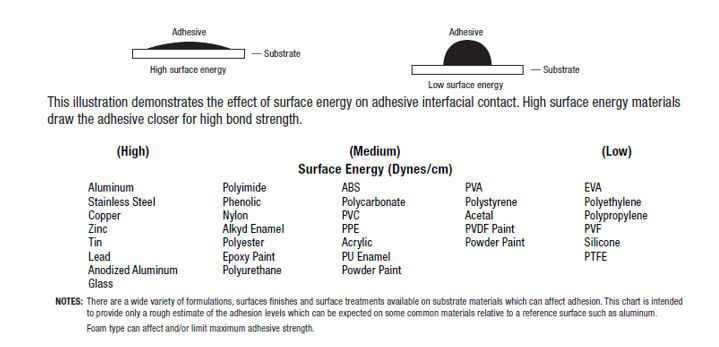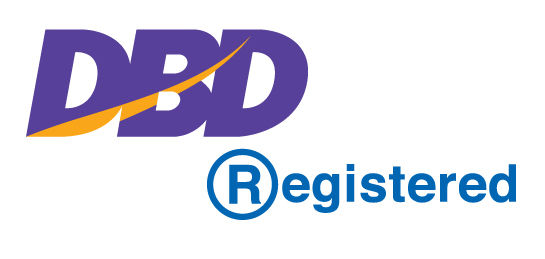Adhesion to the substrate is important in achieving bonding success. Adhesives must flow onto the substrate surfaces in order to achieve intimate contact area and allow the molecular force of attraction to develop. The degree of flow of the adhesive on the substrate is largely determined by the surface energy of the substrate. 3M™ VHB™ Tape GPH series products bond well to high (HSE) and medium (MSE) surface energy materials. The image below shows typical materials in these categories.
Achieving good contact is also important. The necessary thickness of tape depends on the rigidity of substrates and their flatness irregularity. While the 3M™ VHB™ Tapes will conform to a certain amount of irregularity, they will not flow to fill gaps between the materials. For bonding rigid materials with normal flatness, consider use of tapes with thickness of 45 mils (1.1 mm) or greater. As the substrate flexibility increases thinner tapes can be considered.
Using the right amount of tape is important to handle the expected stresses. Because 3M™ VHB™ Tapes are viscoelastic by nature their strength and stiffness is a function of the rate at which they are stressed. They behave stronger with relatively faster rate of stress load (dynamic stresses) and will tend to show creep behavior with stress load acting over a long period of time (static stresses). As a general rule, for static loads, approximately four square inches of tape should be used for each pound (57 cm² of tape per kg) of weight to be supported in order to prevent excessive creep. For dynamic loads a useful design factor is 12 lb/in2 (85 kPa) for most dynamic stresses in general applications.
Allow for thermal expansion/contraction. 3M™ VHB™ Tapes can perform well in applications where two bonded surfaces may expand and contract differentially. Assuming good adhesion to the substrates, the tapes can typically tolerate differential movement in the shear plane up to 3 times their thickness.
Bond Flexibility: While an advantage for many applications where allowing differential movement is a benefit, the tape bonds are typically more flexible than alternative bonding methods. Suitable design modifications or periodic use of rigid fasteners or adhesives may be needed if additional stiffness is required.
Performance in Severe Cold Temperature can be challenging. Applications which require performance at severe cold temperatures must be thoroughly evaluated by the user if the intended use will subject the tape product to high impact stresses. A technical bulletin “3M™ VHB™ Tape Cold Temperature Performance” (70-0707-3991-0) is available for additional information.

All 3M™ VHB™ Tapes have a shelf life of 24 months from date of manufacture when stored at 40°F to 100°F (4°C to 38°C) and 0-95% relative humidity. The optimum storage conditions are 72°F (22°C) and 50% relative humidity.
Performance of tapes is not projected to change even after shelf life expires; however, 3M does suggest that 3M™ VHB™ Tapes are used prior to the shelf life date whenever possible.
The manufacturing date is available on all 3M™ VHB™ Tapes as the lot number, typically marked on the core or on a label on the outer roll lap. The lot number, typically a 4 digit code, is a Julian date (Y D D D). The first digit refers to the year of manufacture, the last 3 digits refer to the days after January 1. Example: A lot number of 7266 (or 17266) would translate to a date of manufacture of Sept. 23 (266th day of year) in 2017.
EN 45545 test report details (ISO 5659-2, ISO 9239-1, ISO 5660-1, ISO 5658-2), UL 746C (File MH17478)
3M and VHB are trademarks of 3M.


















































